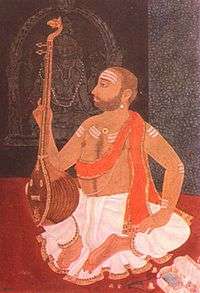Syama Sastri
| Syama Sastri | |
|---|---|
 | |
| Born |
1762 Tiruvarur, Thanjavur district, Tamil Nadu |
| Occupation | Composer |
| Nationality | Indian |
| Genre | Carnatic music |
| Indian classical music |
|---|
| Concepts |
| Music of India | |
|---|---|
 A Lady Playing the Tanpura, ca. 1735 (Rajasthan) | |
| Genres | |
| |
| Media and performance | |
| Music awards | |
| Music festivals | |
| Music media | |
| Nationalistic and patriotic songs | |
| National anthem | Jana Gana Mana |
| Regional music | |
| |
Syama Sastri (also commonly transliterated as Shyama Shastri) (1762–1827) is one of the most renowned composers of Carnatic music. He is the oldest among the Trinity of Carnatic music, Tyagaraja and Muthuswami Dikshitar being the other two.[1]
Career
SYAMA SASTRI was born to Visvanathayya and Vengalakshmi on April 2, 1762.[2] He was a Tamil speaking Brahmin known as Auttara Vadama. Visvanathayya and his forefathers were archakas in the temple of Goddess Bangaru Kamakshi, Thanjavur. Syama Sastri's actual name was Venkata Subrahmanya.
Although Śyāma Śastri did not compose as so many kr̥ti-s as his two prolific contemporaries, his compositions are still well known due to the literary value. It is said that he composed about three hundred pieces in all.
He did not have many disciples to propagate his compositions, nor was the printing press an easy convenience during his time. More importantly, the scholarly nature of his compositions was not appealing to the layperson, they needed to be studied to be savoured.In his compositions there is a perfect blend of Supreme Bhakti (Utmost Devotion), Manodharma Bhavam with adequate Sahityam, but very important all put into the cup of Absolute Talam (Rhythm).
He composed in Telugu and Sanskrit, mostly on goddess Kamakshi.
He composed kritis, varṇa(s) and svarajati(s) with the ankita or mudra (signature) Śyāma Krishna. He was probably the first to compose in a new form of the svarajati musical genre. Prior to this, the svarajati was primarily a dance form, and was close in structure to the dance Varṇaṃ (padavarṇaṃ).
His set of three famous svarajati(s) are intended to be sung in concert rather than danced, and are sometimes referred to as "Ratnatrayam" (Three jewels). They are in ragas Bhairavi, Yadukula kambhoji and Todi, and are called Kāmākṣhī Anudinamu, Kāmākṣhī Padayugamē, and Rāvē himagiri kumāri, respectively. The former two are set to Miśra Cāpu Tāḷa, while the third is set to Ādi Tāḷa.
He was known for his ability to compose in the most complex of Tāḷa(s).[3] He was also known as "Talaprasthara Shyama Sastri" in music circles in those days. He was as adept in composing in rare ragas as he was in composing the popular ones. He was widely revered for his voice and singing ability during his time.
Descendants
Syama Sastri's son, the illustrious Subbaraya Sastri (1803–1862), had the unique privilege of learning under each of the trinity. His kritis with the signature 'Kumara' are known for encapsulating the entire structure of a raga in the space of a single composition. Syama Sastri's adopted grandson, Annasvami Shastri (1827–1900), was also a fine composer.
Compositions
The below sections mention some of his compositions.
Svara Jati
| Composition | Raga | Tāḷa | Language | Description |
|---|---|---|---|---|
| Kāmākṣhī anudinamu maruvakanē కామాక్షీ అనుదినము మరువకనే | Bhairavi | Miśra Cāpu | Telugu | |
| Kāmākṣhī padayugame sthiramaninē | Yadukulakamboji | Miśra Cāpu | Telugu | |
| Rāvē himagiri kumāri రావే హిమగిరి కుమారీ | Todi | Ādi | Telugu | |
Kriti
| Composition | Raga | Tāḷa | Language | Description |
|---|---|---|---|---|
| Śaṅkari Śaṃkuru candra mukhī Sanskrit: शङ्करि शंकुरु चन्द्र मुखी Telugu Script: శఙ్కర శంకురు చన్ద్ర ముఖీ | Sāvēri | Ādi – Tiśra Gati | Sanskrit | |
| kanaka śaila vihāriṇī Sanskrit: कनक शैल विहारिणी Telugu Script: కనక శైల విహారిణీ | Punnāga Varāḷi | Ādi | Sanskrit | |
| Birāna varālicci brōvave బిరాన వరాలిచ్చి బ్రోవవె | Kaḷyāṇi | Ādi – Tiśra Gati | Telugu | |
| Dēvī brōva samayamu దేవీ బ్రోవ సమయము | Cintāmaṇi | Telugu | ||
| Himādri sutē pāhimāṃ హిమాద్రి సుతే పాహిమాం | Kaḷyāṇi | Ādi | Sanskrit | |
| Māyammā yani nē pilacite మాయమ్మా యని నే పిలచితె | Ahiri | Ādi | Telugu | |
| Mari vērē gati evvarammā మరి వేరే గతి ఎవరమ్మా | Anandabhairavi | Miśra Cāpu | Telugu | |
| Nannu brōvu lalitā నన్ను బ్రోవు లలితా | Lalita | Miśra Cāpu | Telugu | |
| O jagadambā nannu ఓ జగదమ్బా నన్ను | Anandabhairavi | Ādi | Telugu | |
| Pārvati ninu nē nera nammiti పార్వతీ నిను నే నెర నమ్మితి | kalkaḍa | Telugu | ||
| Sarōja daḷa nētri himagiri putrī సరోజ దళ నేత్రి హిమగిరి పుత్రీ | śaṃkarābharaṇaṃ | Ādi | Telugu | |
| Tallī ninnu nera namminānu vinavē తల్లీ నిన్ను నెర నమ్మినాను వినవే | Kaḷyāṇi | Miśra Cāpu | Telugu | |
See also
References
- ↑ P. Sambamoorthy, Great Composers, pp69–94. (Madras: The Indian Music Publishing House)
- ↑ http://www.carnaticcorner.com/articles/shyama.html
- ↑ Gopal, Madan (1990). K.S. Gautam, ed. India through the ages. Publication Division, Ministry of Information and Broadcasting, Government of India. p. 231.
